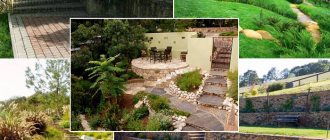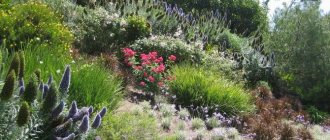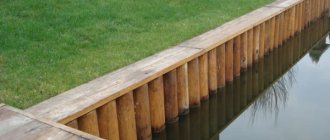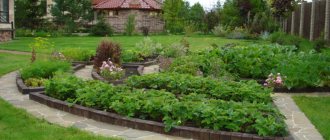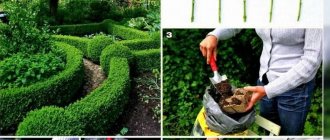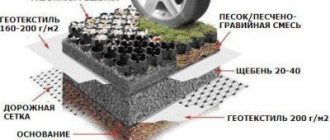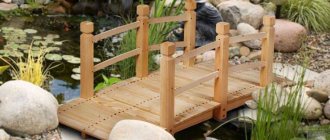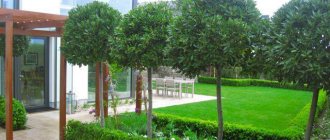Pros and cons of a non-standard site
Land plots of dacha cooperatives, as a rule, rarely suffer from curvature or occasional hills. But a plot far outside the city may surprise you with its unexpected relief. But owners have different attitudes to such problems.
City dwellers rarely visit distant possessions. Mostly on weekends or holidays. They come to enjoy the wild nature and take a break from the bustle of the metropolis. Therefore, landscaping is carried out to a small extent. Only when necessary in the house and yard, and on the territory everything is left as is.
But there are those who want to bring everything to perfection. Because the nature of such people does not tolerate disorder. Even created by nature itself. Therefore, owners of plots with complex terrain are always ready to turn a disadvantage into a highlight. Moreover, everything is not always bad.
And before planning to strengthen the slopes and slopes at your summer cottage, you should carefully study the problem. Consider the advantages that are hidden behind the unsightly appearance. Study the disadvantages to turn them into advantages.
Ravine on the site Source pikabu.ru
Benefits of a site with large differences in level:
- Rainwater never stagnates on a slope.
- The area, which has a slope and faces the sun, produces excellent fruit and is especially suitable for vineyards.
- Unusual relief sometimes provides an opportunity for original design.
- Sometimes the elements of such a landscape practically appear as a ready-made waterfall or alpine slide.
True, the disadvantages still outweigh the advantages. If you plant a slope with plants, you will have to water them more often than usual. Because moisture will not stay in the soil. Turning a steep slope into a lawn is quite difficult. And for a recreation area, complex terrain is either not suitable at all, or will require a lot of work and financial costs.
Strengthening the slope on the site will be necessary in any case if soil slides occur from it. Or it is washed away by water, and all the dirt ends up either in the yard or in the garden. And sometimes you just need to work on the appearance of a ravine and a steep slope so that the unsightly terrain does not catch your eye.
Landslide dangerously close to housing Source izhlife.ru
Available means
One of the simplest and most accessible ways to strengthen the walls of a drainage ditch is to use slate. In this case, you can also use used material. The main thing is that there are no large holes or cracks in it.
The technology using slate is quite simple. Sheets (whole or cut, depending on the size of the ditch) are laid on the slopes of the ditch close to each other. This can be done either strictly vertically or at a slight slope. Then pieces of reinforcement or thin pipes are driven in on both sides of the sheets, in a checkerboard pattern.
This method has both its advantages and disadvantages. The first include the following:
- low financial costs, and if used materials are used, then you can do without investments at all;
- ease of installation. All work can be done by one person.
The disadvantages of this design are its fragility. The appearance of the site itself may also suffer.
Strengthening slopes using old car tires looks more aesthetically pleasing. In addition, this method allows you to make a structure that will last much longer than the slate version (up to several decades).
Here you can resort to two methods, depending on the available space. One involves stacking tires along the edges of a ditch. Soil is poured inside, but sand or gravel is better. For greater reliability, you can drive in metal pipes.
Natural way to strengthen
If the elevation has an inclination angle of no more than eight degrees, then you can arrange a beautiful flower garden of ground cover plants on the hill. A thick palisade of roots will go to a sufficient depth to strengthen the slope in the summer cottage. Thickets of flowers will perfectly protect the soil from erosion and will prevent it from being washed away even by heavy rains.
The choice of ground cover flora is quite large:
- Periwinkle.
- Sunflower.
- Ivy.
- Woolly moth.
You need to choose one type. Well, maximum two. Otherwise, a bright kaleidoscope will bring disharmony. But a floral carpet looks best as a backdrop for flowering trees and shrubs. Larger roots go deeper and wider. If you plant several small trees on a slope and place shrubs between them, you will not be afraid of landslides.
Large and medium-sized plants to strengthen the slope:
- Climbing rose and wild rose.
- Juniper and lilac.
- Hawthorn and blackberry.
- Japanese quince and viburnum.
- Elderberry and sea buckthorn.
But an ornamental garden on a slope has one serious problem. Rain alone is not enough to irrigate it. The water will very quickly leave the top layer and flow down. Therefore, it will be necessary to organize additional and regular watering.
Alpine lawn on a slope Source na-dache.pro
See also: Catalog of companies that specialize in designing and performing landscape work of any complexity
Safety measures on the slope
To avoid the risk of a landslide, every three to four terraces down the slope a permanent wall is built in the form of a gabion or rubble-cement masonry 60-80 cm wide. Such a wall can effectively strengthen a slope 10-15 m long. A stone wall must have binder, for example, cement, lime, clay mortar, or, as in the case of gabion, steel mesh. Often, the masonry is strengthened by installing piles made of asbestos-cement pipes; this makes it possible to seriously strengthen the barrier and reduce the size of the masonry.
Safety paths must be provided on broken terraces. In essence, these are ordinary paths or stairs leading down or up a slope, the base of which is reinforced with geogrid, gravel and anchor rods.
This solution allows you to create terraces of unlimited length without the risk of soil sliding. In addition, drainage trays are installed on the paths, discharging water down the slope of the summer cottage. Of course, paths and stairs can be made in the form of a snake or a broken march, this will only strengthen the slope.
A good addition would be to plant low-growing shrubs, such as gooseberries or currants, along the edge of the terrace; this will strengthen the edge and prevent the terrace from crumbling.
Artificial methods
Let's consider how to strengthen a slope on a summer cottage, which has a steeper angle of inclination. Plants alone will not help here. And we will have to take comprehensive measures. And you need to start with drainage.
It is necessary to protect the slope from rain flows. They are the ones that cause sluggish soil sliding. The fertile layer is usually located on a clay lens and the water helps it slide down very slowly. And the thicker the layer and the steeper the slope, the stronger the movement. Especially if the fertile soil is well diluted with sand.
Geo- and biomats
The simplest strengthening of slopes and slopes with a large angle of inclination can be done using a special coating. Both materials resemble a washcloth in appearance. Geomats are made of polypropylene meshes, which are superimposed on each other and connected thermally. Used on slopes with a slope of up to 70 degrees.
Biomats are a cellulose layer on which either straw or coconut fibers are fixed. Suitable for slopes up to 45 degrees. The mats are laid out on the compacted surface of the slope and secured at the top and bottom. To do this, ditches are dug and the edges of the canvases are fixed in them with crushed stone.
Geomats for strengthening the slope Source edilportale.com
Either grass or low-growing flowers are planted on top of the mats. Plants quickly take root, and their roots bind the canvas to the soil. The result is a kind of soil reinforcement. And now the top layer can easily withstand not only rain flows, but even small seismic shocks.
The advantages of mats are:
- environmental friendliness;
- UV resistance;
- stability under temperature changes;
- survivability in an aggressive environment.
Option 2 - anti-erosion geomats
The structure of the geomat consists of layer-by-layer connected polypropylene lattices fastened with polypropylene threads. Outwardly, it resembles a multi-layered web. The gaps between the threads are small, so the geomat holds the soil of the slope and prevents the spread of vegetation roots. Over time, the plants tightly intertwine with the material and strengthen the walls of the ditch.
Geomat polypropylene is resistant to environmental conditions (exposure to water, sunlight, temperature changes, rotting), non-toxic, and non-fire hazardous.
Laying the coating is easy and can be done even in winter. The work is performed in the following sequence:
- Trench preparation, cleaning.
- We fasten the edge of the roll with anchors to the top of the slope.
- Roll out the material to the bottom of the trench and cut it off.
- The lower part of the piece of material is secured.
- Roll out the next strip of material from top to bottom, overlapping 15 cm with the previous one.
- A 3-5 cm layer of earth is laid out on the covering and seeds are planted. At the same time, the mesh to strengthen the slopes is additionally reinforced with vegetation.
Terraces
Let's look at how to strengthen a slope with fences. This method is especially popular among gardeners and gardeners. It happens that the entire site is located on a slope. In this case, the house is built at the very top. And the rest of the territory is leveled with terraces and planted with fruit trees and vegetable crops.
The width of each site depends on the steepness of the slope. The stronger it is, the narrower the strip of flat land. It is optimal to make a height difference of a maximum of 60 cm. This will simplify the construction of a safe stepped descent to the end of the slope. It will also minimize shading of the garden from fences.
Wooden supports
Leveling the slope begins from the top. First, a series of holes are drilled with a drill in increments of 60 cm to a depth of one meter. Either stakes or pieces of timber are buried in each hole. The wood is pre-treated with an antiseptic. The gaps between the pillars are sewn up with boards.
Wooden terraces Source ymcart.com
Purpose
A site allocated for farming, construction or landscaping rarely has a perfectly flat topography. Much more often, owners are faced with the need to strengthen slopes from sliding after spring floods, snow melting, and heavy rainfall. In addition, when digging a pit, the presence of steep slopes on the site, or the loose, granular structure of the roadbed, measures must be taken to preserve the existing objects within the designated boundaries.
When strengthening, a number of factors are of great importance. Among the important points:
- the magnitude of the slope (if up to 8%, it can be strengthened with natural materials);
- terrain characteristics;
- presence and height of groundwater.
Areas with a more significant slope (more than 8%) have to be strengthened using artificial methods and materials.
Briefly about the main thing
The easiest way to protect the slope from destruction is in a natural way. To do this, its entire surface is planted with plants. From ground cover flowers to shrubs and ornamental trees. If the slope angle does not exceed 8-10 degrees, then this will be enough.
Steep slopes must be additionally strengthened before planting either with geomats or geogrid. And if you want to use the hill for a vegetable garden, then you can’t do without arranging terraces. The method will be labor-intensive, but the result will fully justify itself, both practically and aesthetically.
Ratings 0
With slight steepness
The easiest and cheapest way is to plant vegetation.
The root system of trees will reliably strengthen the soil and prevent its slightest movement. You just need to choose the right species and draw up the optimal planting scheme for a specific area. In addition to trees, some shrubs also provide effective protection against landslides. Examples include such representatives of the flora as cotoneaster, spirea, barberry, climbing rose - the choice is quite large. At the same time as strengthening the soil, shrub plantings can play the role of a hedge and serve as an additional decoration for the site.
https://www.youtube.com/watch?v=uk_KjVL8C7Q
But it is worth considering that any tree will not grow instantly. To “promptly strengthen” the soil, grasses are used, which grow quite quickly, forming a continuous green carpet. And although their roots are not so powerful, if you take into account the total number of these “threads”, it is clear that they form a reliable natural reinforcing mesh.
Loosestrife
This beautiful plant is ideal for decorating a sloping area, and does not require much effort in caring for it. Loosestrife can decorate both the sunny and shady sides of the slope.
If your choice falls on point loosestrife, then it is better to place it on southern slopes, where the sun is a frequent visitor. Loosestrife feels better in the shade or in lowlands where the soil is moister. But the loosestrife is an absolutely unpretentious ground cover plant that is undemanding to its growing location and is even resistant to trampling.
Loosestrife has long, powerful and branched roots that hold the soil together well, so these attractive plants not only decorate, but also strengthen the slopes.
What are gabions?
Gabions are made of galvanized wire.
Gabions are made of galvanized wire coated with PVC. This design can withstand enormous loads, since the mesh has double torsion. Gabion lasts up to 100 years due to its porous structure. You can do it yourself.
Manufacturing stages:
- Reinforcement rods are welded into rectangles of suitable size.
- The size of the cells should be matched to the diameter of the stones.
- Use a shovel to widen the slopes of the ditch.
- Install the welded structure on the banks of the ditch.
- Fill the cells with stones.
- Cover the top of the gabion with chain-link mesh (preferably galvanized, since it does not rust) to enhance the reliability of the structure.
- Reinforce the edges of the mesh with stones.
